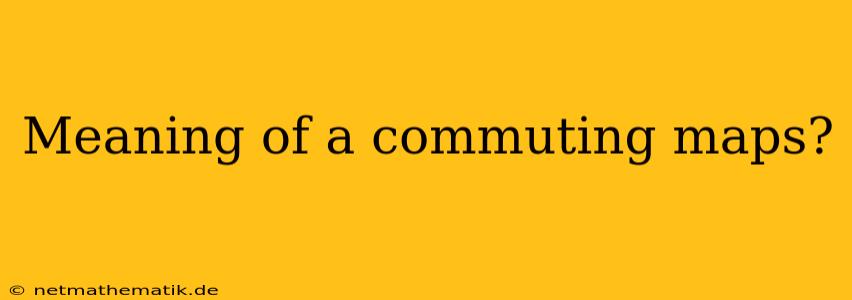Commuting maps, often referred to as morphisms, are fundamental concepts in the realm of abstract algebra and category theory. They serve as bridges between different mathematical structures, enabling us to establish relationships and compare properties across distinct objects. In essence, a commuting map is a function that preserves the underlying structure of the objects it connects. This preservation of structure is key to understanding how different mathematical systems interact and how properties are transferred between them. To fully grasp the meaning of commuting maps, we need to delve into the context of category theory, where they play a pivotal role in defining the relationships between objects.
Category Theory: A Framework for Commuting Maps
Category theory provides a powerful framework for understanding the relationships between mathematical structures. It focuses on objects and commuting maps (also known as morphisms) that connect these objects. A category consists of:
- Objects: These represent the fundamental building blocks of the category, such as sets, groups, topological spaces, or vector spaces.
- Morphisms: These are commuting maps that connect the objects. Each morphism has a source object and a target object.
The key concept in category theory is the notion of commutativity. This refers to the preservation of structure when moving between objects via morphisms.
Understanding Commutative Diagrams
Commutative diagrams are a visual representation of how commuting maps interact within a category. They consist of objects represented by nodes and morphisms represented by arrows connecting these nodes. A diagram is considered commutative if, for any two paths from one node to another, the composition of morphisms along each path yields the same result. This property of commutativity is crucial because it ensures that the structure of the objects is preserved as we move from one object to another via commuting maps.
Examples of Commuting Maps in Different Mathematical Contexts
1. Set Theory:
In set theory, commuting maps are functions that preserve the structure of sets. A function f: A → B between sets A and B is a commuting map if it maps elements of A to elements of B in a way that preserves the relationships between elements. For example, if A and B are sets of integers and f(x) = x + 1, then f is a commuting map because it preserves the order of elements.
2. Group Theory:
In group theory, commuting maps are homomorphisms that preserve the group operation. A homomorphism f: G → H between groups G and H is a commuting map if it maps elements of G to elements of H in a way that preserves the group operation. For example, if G and H are groups of integers under addition and f(x) = 2x, then f is a commuting map because it preserves the addition operation.
3. Linear Algebra:
In linear algebra, commuting maps are linear transformations that preserve the vector space structure. A linear transformation T: V → W between vector spaces V and W is a commuting map if it maps vectors in V to vectors in W in a way that preserves the vector space operations of addition and scalar multiplication.
Importance of Commuting Maps in Mathematics
Commuting maps play a vital role in various areas of mathematics, including:
- Abstract Algebra: They are crucial in studying group theory, ring theory, and field theory.
- Topology: They are used to define continuous functions and homeomorphisms.
- Differential Geometry: They are used to define smooth maps and diffeomorphisms.
- Category Theory: They form the foundation of category theory, providing a framework for studying relationships between mathematical objects.
Conclusion
Commuting maps are a fundamental concept in mathematics that enables us to understand the relationships between different mathematical structures. They are essential for studying various areas of mathematics, including abstract algebra, topology, differential geometry, and category theory. By understanding the meaning of commuting maps and their properties, we gain valuable insights into the interconnectedness of different mathematical systems and the ways in which properties are transferred between them. The study of commuting maps is a cornerstone of modern mathematics, and their significance continues to grow as new areas of mathematics are explored and developed.
